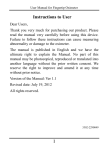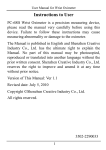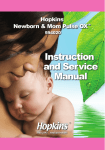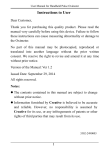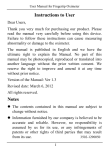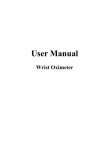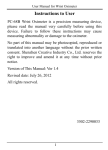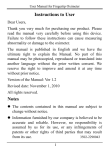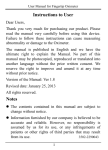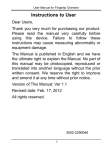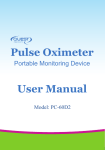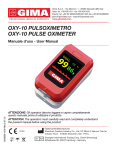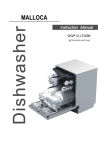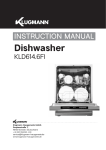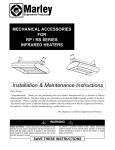Download CREATIVE PC-60NW
Transcript
User Manual for Fingertip Oximeter Instructions to User Dear Users, Thank you very much for purchasing our product. Please read the manual very carefully before using this device. Failure to follow these instructions can cause measuring abnormality or damage to the oximeter. The manual is published in English and we have the ultimate right to explain the Manual. No part of this manual may be photocopied, reproduced or translated into another language without the prior written consent. We reserve the right to improve and amend it at any time without prior notice. Version of the Manual: Ver 1.0 Revised date: October 24, 2012 All rights reserved. 3502-2290052 I User Manual for Fingertip Oximeter Warnings Check the device before using it to make sure that there is no visible damage which may affect user’s safety or its performance with regard to sensors and clips. It is recommended that the device should be inspected minimally once a week. When there is obvious damage, stop using the device. Special attention should be paid while the oximeter is used constantly under the ambient temperature over 37°C, burning hurt may occur because of over-heating of the sensor at this situation. An uncomfortable or painful feeling may appear if the oximeter is used continuously on the same place for a long time, especially for poor microcirculation patients. It is recommended that the oximeter should not be applied to the same location for longer than 2 hours. If any abnormal condition is found, please change the placing site of oximeter. Avoid placing the device on the same limb which is wrapped with a cuff for blood pressure measurement or during venous infusion. II User Manual for Fingertip Oximeter DO NOT clip this device on edema or tender tissue. The light (the infrared light is invisible) emitting from the device is harmful to the eyes, so service technician or testee should not stare at the light. The oximeter is not a treatment device. When disposing of this device and its accessories, the local law should be followed. Instructions for Operation The finger should be put in properly and correctly. Do not shake the finger. Keep at ease during measurement. Do not put wet finger directly into sensor. Do not let anything block the emitting light from the device. Ensure that there is artery vessel within measuring site where the light transmits through. Vigorous exercise and the interference from the electrosurgical device may affect the measuring accuracy. Nail polish may affect the measuring accuracy, and too long fingernail may cause failure of measurement or inaccurate result. III User Manual for Fingertip Oximeter Keep the oximeter away from dust, vibration, corrosive substances, explosive materials, high temperature and moisture. Existence of high intensive light sources, such as fluorescence light, ruby lamb, infrared heater or strong sunshine, etc. may cause inaccuracy of measurement result. Please put an opaque cover on the sensor or change the measuring site if necessary. If the first reading appears with poor waveform (irregular or not smooth), then the reading is unlikely true, the more stable value is expected by waiting for a while, or a restart is needed when necessary. IV User Manual for Fingertip Oximeter Declaration of Conformity: The manufacturer hereby declares that this device complies with the following standards: IEC 60601-1 IEC 60601-1-2 ISO 9919 and follows the provisions of the council directive MDD 93/42 EEC Caution: U.S. federal law restricts this device to sale or use by or on the order of a physician. V User Manual for Fingertip Oximeter Content 1 Overview ..................................................................... 1 1.1 Appearance ........................................................... 1 1.2 Name and Model .................................................. 2 1.3 Intended Use ......................................................... 2 1.4 Structure and Conformation ............................... 2 1.5 Features................................................................. 2 2 Battery Installation..................................................... 3 3 Operation .................................................................... 4 3.1 Directly Measurement .......................................... 4 3.2 Over-limit indication and Beep Silence ............... 8 3.3 Setup Menu Screen............................................... 9 3.4 Data transmission ............................................... 10 4. Technical Specifications .......................................... 11 5. Accessories ............................................................... 13 6. Repair and Maintenance ......................................... 13 6.1 Oximeter Maintenance....................................... 13 VI User Manual for Fingertip Oximeter 6.2 Cleaning and Disinfecting Instruction .............. 15 7. Troubleshooting ....................................................... 16 Appendix ...................................................................... 17 A. Key of Symbols ..................................................... 17 B. SpO2 Common Knowledge.................................... 18 VII User Manual for Fingertip Oximeter 1 Overview 1.1 Appearance Figure 1 Front/Rear View 1 User Manual for Fingertip Oximeter 1.2 Name and Model Name: Fingertip Oximeter Model: PC-60NW 1.3 Intended Use This Fingertip Oximeter is intended for measuring the pulse rate and functional oxygen saturation (SpO2) through patient’s finger. It is applicable for spot-checking SpO2 and pulse rate of adult and pediatric patients in homes and clinics. 1.4 Structure and Conformation It consists of main unit and photoelectric sensor. 1.5 Features • Wireless data transmission can communicate with PC/mobile phone/PDA. • Large true color OLED display of SpO2, PR Pulse Bar, PI & Plethysmogram • Innovative 4 directions display • Automatic power on/off • Audible & visible over-limit indication, high & low limits are adjustable • Shift parameter display between PR and PI 2 User Manual for Fingertip Oximeter • 2AAA alkaline batteries with low power consumption • Low battery voltage indication 2 Battery Installation Figure 2 Battery Installation 1. Refer to Figure 2, insert two AAA size batteries into the battery compartment properly. 2. Replace the cover. Please make sure that the batteries are correctly installed since the incorrect installation may cause the device inoperable. 3 User Manual for Fingertip Oximeter 3 Operation 3.1 Directly Measurement 1. Open the clip as shown in Figure 3. Figure 3 Put finger into the Oximeter 2. Put finger into the rubber cushions of the clip (make sure the finger is in the correct position), and then clip the finger. 3. The device will power on automatically in 2 seconds, and start to display software version number. 4. Next enter into data display screen (as shown in Figure 4). The user can read the values and view the waveform from display screen. Shift parameter display between PR and PI during measurement: Short time press Display Key, the display orientation will rotate 90 degree, at the same time, PR value shift to PI value automatically and there is no waveform displayed as shown in 4B. But if no operation is performed during the first 20 seconds, the PI value will change to PR value 4 User Manual for Fingertip Oximeter automatically as shown in figure 4C. Press the key again, the screen will change its direction as shown in 4D. It obviously shows that the alternative display between parameter PR and PI is under the condition that the direction of screen is rotated to the left and right side, which is accompanied by no waveform displayed as shown in 4B and 4E. After 20 seconds without operation, the PI will automatically shift back to PR, as shown in 4C and 4F. Figure4A Figure4B Figure4C Figure4D Figure4E Figure4F 5 User Manual for Fingertip Oximeter Screen Description: “%SpO2”: SpO2 symbol; “99”: SpO2 value; “PR”: Pulse Rate icon; “65”: Pulse Rate value; “ ”: Pulse beat symbol; “ ”: Pulse intensity bar graph; “PI%”: Perfusion index icon; “1.4”: Perfusion Index value; “ ”: Wireless symbol. Wireless icon“ ”: The color of “ ” Definition The device is being to establish “ ” flashes blue a wireless connection with the surrounding host. “ ” long lights blue Successful wireless connection between the device and a host is established. 6 User Manual for Fingertip Oximeter No display“ ”icon 1."Wireless" function is disabled; 2. The device fails to setup a wireless connection with the surrounding host within 3 minutes; 3. Hardware failure of wireless transmission function while the “Wireless” function is enabled. 7 User Manual for Fingertip Oximeter 3.2 Over-limit indication and Beep Silence When measuring, if SpO2 value or pulse rate value exceeds the preset alarm limit, the device will beep automatically and the value which exceeds limit on the screen will flash. The detailed information refers to chapter 4. When the beep sound is activated by over-limit, it will become silent at the following situations: 1. The SpO2 and PR value return to normal range. 2. Press Display Key to mute. If this over-limit event continues, the oximeter will resume beeping automatically later in 2 minutes. 3. Remove the finger from the oximeter or SpO2 probe. 8 User Manual for Fingertip Oximeter 3.3 Setup Menu Screen Figure 5 Menu Screen Long time pressing display key could enter the setup menu screen. Setup Menu Screen Description: “Wireless”:The wireless on-off button. There are 2 selectable options: “on” and “off”. The device transmits data to PC when it is on. “SpO2 alm Lo”:SpO2 low limit. The user can modify the value within 85~99 with “1” as a step. “PR alm Hi”:Pulse Rate high limit. The user can modify the value within 100~240 with “5” as a step. “PR alm Lo”:Pulse Rate low limit. The user can 9 User Manual for Fingertip Oximeter modify the value within 30~60 with “1” as a step. “Save, exit menu”:Longtime pressing this item to store settings and exit to the normal display screen from the setup menu. On setup menu screen: 1. Short time press Display Key to choose the setting item; 2. Longtime press Display Key to activate the setting item, then short time press it to modify the setting parameter; 3. Next, longtime press Display Key to confirm the modification and exit from this setting item. 4. At last, move the setting item to “Save, exit menu”, and long time pressing Display Key to store the modification and exit from the setup menu. 3.4 Data transmission This oximeter has the feature of wireless data transmission,the display reading can be transmitted to a computer effectively via the wireless communication function. Refer to the manual “Oximeter Data Manager” for detailed information. 10 User Manual for Fingertip Oximeter 4. Technical Specifications A. SpO2 measurement Technique: dual-wavelength LED sensor with wavelength: Red light: 663 nm, Infrared light: 890 nm. Maximal optical output power: <= 1.5mW Measuring range: 35%~100% Measuring accuracy: Arms <= 3% for SpO2 range from 70% to 100% Note: Arms is defined as root-mean-square value of deviation according to ISO 9919. SpO2 low limit setting range: 85%~99% B. Pulse Rate measurement Measuring range: 30bpm~240bpm Measuring accuracy: ±2bpm or ±2% (whichever is greater) Pulse Rate limit setting range: high limit: 100~240bpm low limit: 30~60bpm C. Perfusion Index (PI) Display Range: 0.2%~20% 11 User Manual for Fingertip Oximeter D. Audible &visual over-limit indication When measuring, if SpO2 value or pulse rate value exceeds the preset limit, the device will beep automatically and the value which exceeds limit on the screen will flash. The oximeter will shut down automatically in 8 seconds with no signal. E. Display mode:Color OLED Display F. Power supply requirement: 2 x LR03 (AAA) alkaline batteries Supply voltage: 3.0VDC Operating current: ≤40mA G. Environment requirement Operating Temperature: 5 ~40°C Operating Humidity: 30~80% Atmospheric pressure: 70~106kPa H. The performance under low perfusion condition The accuracy of SpO2 and PR measurement still meets the specification described above when the pulse modulation amplitude is as low as 0.6%. I. Resistance to interference of surrounding light: The difference between the SpO2 value measured in the condition of indoor natural light and that of darkroom is less than ±1%. 12 User Manual for Fingertip Oximeter J. Dimensions: 60 mm (L) × 33 mm (W) × 30 mm (H) Net Weight: 35g (including battery) K. Classification: The type of protection against electric shock: Internally powered equipment. The degree of protection against electric shock: Type BF applied parts. The degree of protection against harmful ingress of liquids: Ordinary equipment without protection against ingress of water. Electro-Magnetic Compatibility: Group I, Class B 5. Accessories A. A lanyard B. Two batteries C. A pouch D. A User Manual E. Quality Certificate Note: The accessories are subject to change. Detailed items and quantity see the Packing List. 6. Repair and Maintenance 6.1 Oximeter Maintenance 13 User Manual for Fingertip Oximeter The service life (not a warranty) of this device is 5 years. In order to ensure its long service life, please pay attention to the use of maintenance. Please change the batteries when the low-voltage indicator lightens. Please clean the surface of the oximeter before use. Use soft cloth with alcohol to wipe the oximeter first, and then let it dry in air or wipe it dry. Please take out the batteries if the oximeter will not be used for a long time. The recommended storage environment of the device: ambient temperature: -20ºC ~60ºC, relative humidity 10%~95%, atmospheric pressure: 50kPa~107.4kPa. The oximeter is calibrated in the factory before sale, so there is no need to calibrate it during its life cycle. However, if it is necessary to verify its precision routinely, the user can do the verification by means of SpO2 simulator, or it can be done by the local third party test house. 14 User Manual for Fingertip Oximeter Necessary servicing must be performed by qualified service engineers ONLY. Users are not permitted to maintain it by themselves. High-pressure sterilization cannot be used on the device. Do not immerse the device in liquid. 6.2 Cleaning and Disinfecting Instruction Surface-clean sensor with a soft cloth by wetting with a solution such as 75% isopropyl alcohol, if low-level disinfection is required, use a 1:10 bleach solution. Then surface-clean by soft cloth wet with clean water and let air dry or wipe it dry. Caution: Do not sterilize by irradiation steam, or ethylene oxide. Do not use the sensor if it is damaged. 15 User Manual for Fingertip Oximeter 7. Troubleshooting Trouble The SpO2 and Pulse Rate display instable Cannot turn on the device No display Possible Reason Solution 1. The finger is not placed far enough inside. 2. The finger is shaking or the patient is moving. 1. Place the finger correctly inside and try again. 2. Let the patient keep calm. 1. The batteries are drained or almost drained. 2. The batteries are not inserted properly. 3. The device is malfunctioning. 1. The device will power off automatically when it gets no signal for 8 seconds. 2. The batteries are almost drained. 1. Change batteries. 2. Reinstall batteries. 3. Please contact the local service center. 16 1. Normal. 2. Change batteries. User Manual for Fingertip Oximeter No display of the wireless icon “ ” when it is enabled Hardware failure of wireless transmission function. Please contact the local service center. Appendix A. Key of Symbols Symbol Description With Type BF applied part Warning ─ See User Manual %SpO2 PR Oxygen saturation (percentage) Pulse rate (beats per minute) Pulse rate icon Wireless icon Low battery voltage SN Serial number 17 User Manual for Fingertip Oximeter B. SpO2 Common Knowledge 1. Meaning of SpO2 SpO2 is the saturation percentage of oxygen in the blood, so called O2 concentration in the blood; it is defined by the percentage of oxyhemoglobin (HbO2) in the total hemoglobin of the arterial blood. SpO2 is an important physiological parameter to reflect the respiration function; it is calculated by the following method: SpO2 = HbO2/ (HbO2 +Hb)×100% HbO2 are the oxyhemoglobins (oxygenized hemoglobin), Hb are those hemoglobins which release oxygen. 2. Principle of Measurement Based on Lamber-Beer law, the light absorbance of a given substance is directly proportional with its density or concentration. When the light with certain wavelength emits on human tissue, the measured intensity of light after absorption, reflecting and attenuation in tissue can reflect the structure character of the tissue by which the light passes. Due to that oxygenated hemoglobin (HbO2) 18 User Manual for Fingertip Oximeter and deoxygenated hemoglobin (Hb) have different absorption character in the spectrum range from red to infrared light (600nm~1000nm wavelength), by using these characteristics, SpO2 can be determined. SpO2 measured by this oximeter is the functional oxygen saturation -- a percentage of the hemoglobin that can transport oxygen. In contrast, hemoximeters report fractional oxygen saturation – a percentage of all measured hemoglobin, including dysfunctional hemoglobin, such as carboxyhemoglobin or metahemoglobin. Clinical application of pulse oximeters: SpO2 is an important physiological parameter to reflect the respiration and ventilation function, so SpO2 monitoring used in treatment has become more popular. (For example, such as monitoring patients with serious respiratory disease, patients under anesthesia during operation and premature and neonatal infants) The status of SpO2 can be determined in timely manner by measurement and will allow finding the hypoxemia patient earlier, thereby preventing or reducing accidental death caused by hypoxia effectively. 19 User Manual for Fingertip Oximeter 3. Factors affecting SpO2 measuring accuracy (interference reason) Intravascular dyes such as indocyanine green or methylene blue Exposure to excessive illumination, such as surgical lamps, bilirubin lamps, fluorescent lights, infrared heating lamps, or direct sunlight. Vascular dyes or external used color-up product such as nail enamel or color skin care Excessive patient movement Placement of a sensor on an extremity with a blood pressure cuff, arterial catheter, or intravascular line Exposure to the chamber with High pressure oxygen There is an arterial occlusion proximal to the sensor Blood vessel contraction caused by peripheral vessel hyperkinesias or body temperature decreasing 20 User Manual for Fingertip Oximeter 4. Factors causing low SpO2 Measuring value (pathology reason) Hypoxemia disease, functional lack of HbO2 Pigmentation or abnormal oxyhemoglobin level Abnormal oxyhemoglobin variation Methemoglobin disease Sulfhemoglobinemia or arterial occlusion exists near sensor Obvious venous pulsations Peripheral arterial pulsation becomes weak Peripheral blood supply is not enough Guidance and manufacturer’s declaration The following tables (Table 1 to 4) provide the specific information regarding this device's compliance to IEC 60601-1-2. 21 User Manual for Fingertip Oximeter Table 1 Guidance and manufacturer’s declaration electromagnetic emissions The device is intended for use in the electromagnetic environment specified below. The user of this device should assure that it is used in such an environment. Compli Electromagnetic Emissions test ance environment – guidance This device uses RF energy only for its internal RF emissions function. Therefore, its RF Group CISPR 11 emissions are very low 1 and are not likely to cause any interference in nearby electronic equipment. RF emissions CISPR 11 Harmonic emissions IEC 61000-3-2 Voltage fluctuations/flicker emissions IEC 61000-3-3 Class B N/A N/A 22 This device is suitable for use in all establishments, including domestic and those directly connected to the public low-voltage power supply network that supplies buildings used for domestic purposes. User Manual for Fingertip Oximeter Table 2 Guidance and manufacturer’s declaration - electromagnetic immunity The device is intended for use in the electromagnetic environment specified below. The user of this device should assure that it is used in such an environment. Compli Electromagnetic IEC 60601 Immunity ance environment test test level level guidance Electrostatic ±6 kV ±6 kV Floors should be wood, concrete or discharge contact contact (ESD) ±8 kV air ±8 kV ceramic tile. If floors are covered IEC air with synthetic 61000-4-2 material, the relative humidity should be at least 30%. Electrical ±2 kV for fast power transient/bur supply lines N/A N/A st ±1 kV for IEC61000-4 input/output -4 lines Surge IEC 61000-4-5 ±1 kV line (s) to line(s) ±2 kV line(s) to earth N/A 23 N/A User Manual for Fingertip Oximeter Voltage dips, short interruptions and voltage variations on power supply input lines IEC 61000-4-11 <5 % UT (>95 % dip in UT) for 0.5 cycle 40 % UT (60 % dip in UT) for 5 cycles 70 % UT (30 % dip in UT) for 25 cycles <5 % UT (>95 % dip in UT) for 5 s N/A N/A Power frequency Power magnetic fields frequency should be at levels (50/60Hz) characteristic of a magnetic 3 A/m 3 A/m typical location in a field typical commercial IEC61000-4 or hospital -8 environment. NOTE: UT is the a.c. mains voltage prior to application of the test level. 24 User Manual for Fingertip Oximeter Table 3 Guidance and manufacturer’s declaration – electromagnetic immunity The device is intended for use in the electromagnetic environment specified below. The user of this device should assure that it is used in such an electromagnetic environment. IEC Compli Immunity Electromagnetic 60601 test ance test environment - guidance level level Portable and mobile RF communications equipment should be used no closer to any part of this device, including cables, than the recommended Conducte 3 Vrms N/A separation distance d RF 150 kHz calculated from the IEC to 80 equation applicable to 61000-4-6 MHz the frequency of the transmitter. Recommended separation distance Radiated 3 V/m 3 V/m RF 80 MHz IEC to 2.5 61000-4-3 GHz 25 User Manual for Fingertip Oximeter Where P is the maximum output power rating of the transmitter in watts (W) according to the transmitter manufacturer and d is the recommended separation distance in meters (m). Field strengths from fixed RF transmitters, as determined by an electromagnetic site survey ,a should be less than the compliance level in each frequency range .b Interference may occur in the vicinity of equipment marked with the following symbol. NOTE 1 : At 80 MHz and 800 MHz, the higher frequency range applies. NOTE 2 : These guidelines may not apply in all situations. Electromagnetic propagation is affected by absorption and reflection from structures, objects and people. 26 User Manual for Fingertip Oximeter a: Field strengths from fixed transmitters, such as base stations for radio (cellular / cordless) telephones and land mobile radios, amateur radio, AM and FM radio broadcast and TV broadcast cannot be predicted theoretically with accuracy. To assess the electromagnetic environment due to fixed RF transmitters, and electromagnetic site survey should be considered. If the measured field strength in the location in which the device is used exceeds the applicable RF compliance level above, the device should be observed to verify normal operation. If abnormal performance is observed, additional measures may be necessary, such as re-orienting or relocating this device. b: Over the frequency range 150 kHz to 80 MHz, field strengths should be less than 3V/m. 27 User Manual for Fingertip Oximeter Table 4 Recommended separation distances between portable and mobile RF communications equipment and the device The device is intended for use in an electromagnetic environment in which radiated RF disturbances are controlled. The user of this device can help prevent electromagnetic interference by maintaining a minimum distance between portable and mobile RF communications equipment (transmitters) and this device as recommended below, according to the maximum output power of the communications equipment. Separation distance according to frequency of Rated transmitter maximum m output power 150 kHz to 80 MHz to 800 MHz to of transmitter 80 MHz 800 MHz 2.5 GHz W 0,01 0,1 1 10 100 N/A N/A N/A N/A N/A 0.12 0.38 1.2 3.8 12 28 0.23 0.73 2.3 7.3 23 User Manual for Fingertip Oximeter For transmitters rated at a maximum output power not listed above, the recommended separation distance d in meters (m) can be estimated using the equation applicable to the frequency of the transmitter, where P is the maximum output power rating of the transmitter in watts (W) according to the transmitter manufacturer. NOTE 1: At 80 MHz and 800 MHz, the separation distance for the higher frequency range applies. NOTE 2: These guidelines may not apply in all situations. Electromagnetic propagation is affected by absorption and reflection from structures, objects and people. 29




































